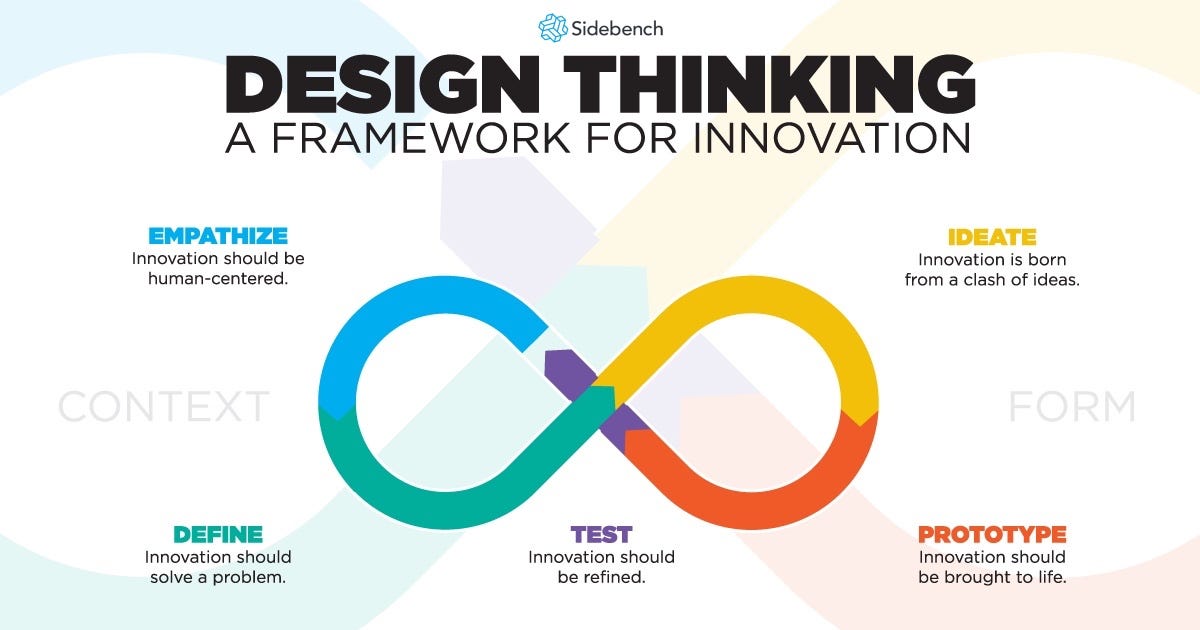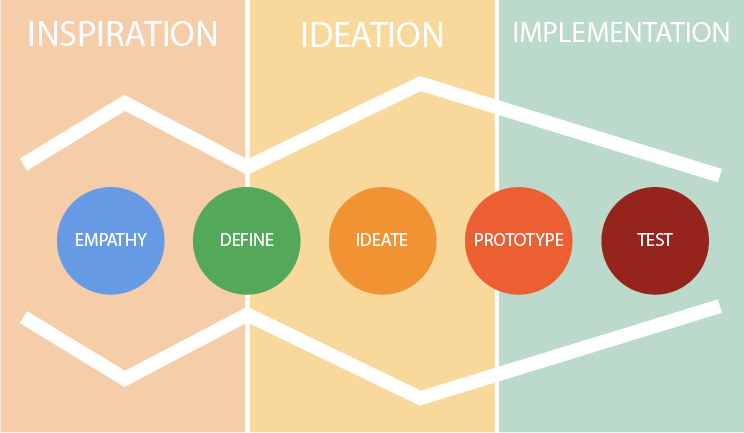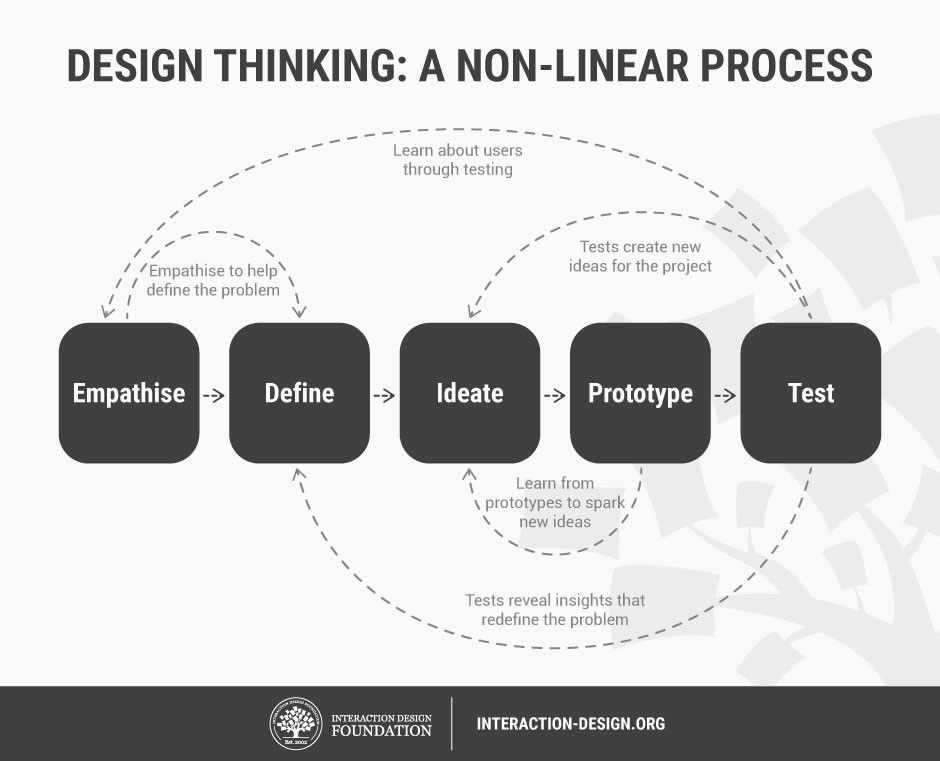

In this article, I’ll explore how design thinking not only drives innovative product development, it surfaces opportunities to wow your customers by building brand loyalty, competitive advantages, and ultimately driving positive ROI.
Design thinking is a key component of any company looking to regularly introduce innovative ideas. It follows a proven, repeatable process that puts the end user front and center of every decision you make. This comes naturally to a seasoned product team, but is a strategy that needs to be embraced across the entire organization.
“More than just aesthetics, design thinking is a process through which human-centered solutions are crafted.”
Design thinking is a process for creative problem solving.
Design thinking has a human-centered core. It encourages organizations to focus on the people they're creating for, which leads to better products, services, and internal processes. When you sit down to create a solution for a business need, the first question should always be what's the human need behind it?
In employing design thinking, you’re pulling together what’s desirable from a human point of view with what is technologically feasible and economically viable. It also allows those who aren't trained as designers to use creative tools to address a vast range of challenges. The process starts with taking action and understanding the right questions. It’s about embracing simple mindset shifts and tackling problems from a new direction.
Why Is Design Thinking Important?
- It can help you or your team surface unmet needs of the people you are creating for.
- It reduces the risk associated with launching new ideas.
- It generates solutions that are revolutionary, not just incremental.
- It helps organizations learn faster.
3 Essential Pillars of Design Thinking
- Empathy — Understanding the needs of those you’re designing for.
- Ideation — Generating a lot of ideas. Brainstorming is one technique, but there are many others.
- Experimentation — Testing those ideas with prototyping.
Done Right, Design Thinking...
- Captures the mindsets and needs of the people you're creating for.
- Paints a picture of the opportunities based on the needs of these people.
- Leads you to innovative new solutions starting with quick, low-fidelity experiments that provide learning and gradually increase in fidelity.
Areas Where Design Thinking Can Apply
- Product design
- Service and experience design
- Business design
- Leadership
- Organizational change
What Does It Look Like to Be Good at Design Thinking?
The great beauty of design thinking is that the essential elements combine to form an iterative approach. It may not always proceed linearly, but there’s a roadmap to help move you toward your solution. It starts with identifying a driving question that inspires you and your team to think about who you’re really designing for, and what they actually need. Next, you gather inspiration—what other solutions out in the world can help you rethink the way you’re working? Use that to push past obvious solutions, and arrive at breakthrough ideas. Build rough prototypes to make those ideas tangible, and find what’s working and what’s not. Gather feedback, go back to the drawing board, and keep going. And once you’ve arrived at the right solution, craft a story to introduce it to your colleagues, clients, and its users. Some of those steps may happen several times, and you may even jump back and forth between them. But that roadmap can take you from a blank slate to a new, innovative idea.
Ways to Get Started with Design Thinking Now
Getting to know your customers is the first step toward creating products and services they want and need. Don’t assume you know what someone thinks or feels. Gathering information about your target consumer is a critical piece of the design thinking approach. Build your interview skills with these tips.
Build Scrappy Prototypes to Learn About Unmet Needs
You don’t need lots of time or resources to prototype. Begin with pen and paper or other accessible resources, like a slide deck, to mock up ideas and get feedback that will help you better understand the needs of your customers before investing in production.
At IDEO, we worked with a large media firm undergoing a big reorganization. The team prototyped possible changes to the organizational structure by using constraints to create 6-week experimental teams. The goal was not for the teams to succeed necessarily, but for the company to gain some learnings that could inform a better structure.
Turn Problems into Questions
When presented with a problem, resist the urge to find a solution right away. Shift your mindset to instead ask a question that might get you closer to the root of the challenge or support an incremental improvement.
Take the example of an IDEO team that was working with a company that was struggling with retention. Instead of focusing on improving retention rates, they asked: “How can we make a better employee experience?” By refocusing on the real human needs, they uncovered insights that were better able to drive toward a solution.
Use Research to Understand the Past, Present, and Future
IDEO typically uses lots of different research techniques to generate insights around the needs of people including, but not limited to, observation, interviewing, immersive empathy, and exploring extreme users. Generally, the types of research you can do fall into three buckets. Generative research helps identify new opportunities and explore needs. Evaluative research gathers feedback on experiments and helps you iterate forward. These two types of research are focused on the future and new ideas. Traditional market research is known as validating research—intended to understand what is currently happening. Balance your research approach to focus on what’s happening now and what could be in the future.
CONCLUSION:
Design thinking is, above all, a highly specific mindset encompassing a wide range of practices and methods used by designers. The approach, which ties up together all these actions within a common methodology, has managed to make its way into the corporate world and win a seat at the table next to other, more linear, processes.
The design thinking is a paradigm shift, from product-centered design to human-centered design, it borrows many practices from ethnography, sociology and other deep contextual customer research. It starts with user data, creates design artifacts that address real and not imaginary user needs, and then tests those artifacts with real users.
Design Thinking is a banner for different approaches, they differ in their outcome and the origin of the problem.
Design Thinking (also known as Meta Design Thinking, Strategic Design Thinking) starts with a systemic vision with no outcome assumptions and results in diverse outcomes.
Product Design Thinking starts with product creation assumptions and results in product outcomes.
Service Design Thinking starts with service creation assumptions and results in service outcomes.
Experience Design Thinking starts with experience creation assumptions and results in experience outcomes.
Two processes of the Design Thinking are popular, one with 5 steps from the d.school and another one with 3 steps from IDEO, each one can bring you a meaningful structure for your creativity process.

Keep in mind that empathy is a key quality for design thinking, as the ability to understand your customers to answer their needs. This empathy insures you to address real problem and give meaning to your solution. A wonderful interface solving the wrong problem will fail.

Mastering Design Thinking
Beijing opens glitzy 'starfish' airport ahead of China's 70th anniversary

Higher education in the era of IR 4.0

FINTECH CONFERENCE 2019
Asian Family Values in the 21st Century: Overview of Comparative Asian Family Survey Data
Regards from me;
Sanisah Hanim Jiman
Kolej MARA Kuala Nerang





2 Comments
Interesting blog, good information is provided regarding design thinking for business strategy. Was very useful, thanks for sharing this useful blog with us.
ReplyDeleteHey! Excellent work. Being a QuickBooks user, if you are struggling with any issue, then dial QuickBooks Customer Service Our team at QuickBooks will provide you with the best technical solutions for QuickBooks problems.
ReplyDelete